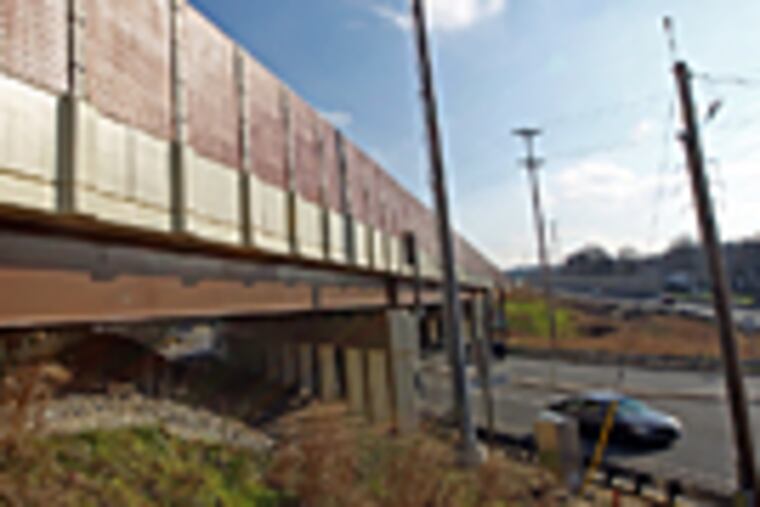Area's repaired bridges have high rate of cracks
Recently constructed highway bridges in Southeastern Pennsylvania are cracking at unexpectedly high rates, forcing expensive repairs that will delay new projects.

Recently constructed highway bridges in Southeastern Pennsylvania are cracking at unexpectedly high rates, forcing expensive repairs that will delay new projects.
The cracking on the decks of concrete bridges may cost $10 million to fix, and that "will mean some other things won't be done," said Charles Davies, assistant district executive for design for the Pennsylvania Department of Transportation's Southeastern district.
The discovery comes as PennDot struggles to fix or replace Pennsylvania's nation-leading number of structurally deficient bridges.
The unexpected cracks don't endanger drivers but could severely reduce the bridges' expected 50-year life if not repaired promptly, said George Dunheimer, PennDot's assistant district executive for construction.
Some of the most severe cracking is on new bridge decks on the rebuilt 309 Expressway in Montgomery County between Cheltenham Avenue and State Route 63. The roadway, including 24 bridges, was rebuilt between 2004 and 2010 at a cost of $375 million.
Three of the bridges on 309 display "excessive" cracking, Dunheimer said, and about a dozen others "have more than I'd like to see."
Another bridge with excessive cracking is a span on Route 179 (Bridge Street) over the Delaware Canal in New Hope. That bridge construction was completed in June 2009.
The new cracks typically are less than 1/25th of an inch wide, but some go all the way through an 8.5-inch deck, engineers said. That allows water and highway salt to get in and cause rapid deterioration of the bridge.
Repairs can involve pouring a thin sealant into the cracks, injecting epoxy, or spreading a layer of urethane epoxy with stone chips over the cracks.
The repairs will mean the return of traffic restrictions to the newly rebuilt bridges.
"Lane closures would be required to apply the material on the bridge deck," said PennDot spokesman Gene Blaum. "This work would be done at night during overnight hours on a busy highway such as Route 309 to minimize traffic impacts."
Some concrete cracking is inevitable on all bridges, engineers say, but the cracks on many of PennDot's newly built or reconstructed bridges are much more numerous and closer together than is typical.
PennDot engineers said several factors may cause the cracking, including the size of a bridge, vibrations caused by traffic during construction, and the chemistry of the concrete itself, which can result in the material getting too hot as it cures.
Similar cracking is being discovered in recently constructed bridges around the state, and PennDot is preparing in 2012 to launch a statewide analysis of the cracking and what to do about it, said Lester Toaso, PennDot district executive for Southeastern Pennsylvania.
Toaso said two different contractors built the 309 Expressway bridges "under our work methods . . . and nothing was found wrong with the workmanship."
He said PennDot has now switched to "high-performance concrete" to "lower the thermal gradient," but he acknowledged that is "probably not the ultimate solution."
With a construction budget of about $350 million for the current year, PennDot's Southeastern district already is working with about 30 percent less money than it had two years ago, when federal stimulus funds boosted available funding.
Diverting $10 million to repair recently built bridges will mean other highway and bridge work in the five-county Philadelphia region will be postponed.
"Ten million is a big hit," Davies said. "It will have an effect."
If the problem is similarly severe in the 10 other PennDot districts, that would mean a $110 million drain on the state highway budget.
Pennsylvania, with more structurally deficient bridges than any state in the country, has been working in recent years to replace and repair its bad spans.
PennDot has reduced the number of deficient bridges from an all-time high of 6,034 in 2008 to 5,069 as of September 2011. The state has about 25,000 bridges, and the average age is 53 years.
In the five-county Philadelphia area, 521 of 2,745 state bridges are rated structurally deficient, down from a high of 604 in July 2007.
After three years of an "accelerated bridge repair" program, Pennsylvania spent less on bridge repair in 2011 than a year earlier, and faces another tight budget year in 2012.
Even so, about 100 bridges were repaired or reconstructed last year in Southeastern Pennsylvania, where all of the state's most heavily traveled deficient bridges are located.
The need to fix the cracking bridges will "mean making reductions elsewhere," Toaso said.
PennDot officials and regional planners are now deciding which projects to fund in the coming years.